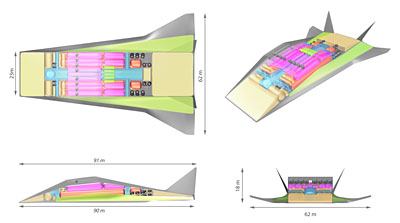js117,
The discussion your link leads to brings up many of the points that I have tried to address; I am not proposing to accelerate the stack to anywhere near supersonic speeds, just to a high enough speed that the carrier wing will have plenty of lift; the stack sits in a cradle which is supported by wheels, not a magnetic levitation system; the carrier wing allows orbital inclination to be independent of the catapult orientation; because the stack is only being accelerated to about 350 mph, the launch track does not have to be 20 miles long, but I wouldn't be surprised if it was ten miles long, because enough length must be included for an abort from full take-off speed.
That discussion touches on some wonderful concepts, but I am in a hurry. I want something that could be operational in 5 years, if we spend the money on it. The system described in that discussion is a minimum of 20 years out, possibly more. I don't think that we can wait until the necessary advances are made, if we want to be sure that access to space will continue. We have a window of time, which is closing rapidly, in which to accomplish getting ourselves established in space. There simply are not enough young engineers in the world to be able to guide a large-scale industrial revolution in space right now, and the number is dwindling rapidly, as people retire.
I believe that the system that I propose could be the primary method of putting people into space after a short introductory time, and that developing it would allow us to avoid the cost of man-rating any step rockets. It wouldn't hurt to man-rate something like the Falcon 9, but we really don't want to wait around until they can afford to fly often enough to establish the man-rating. The Soyuz is an adequate back up vehicle, if our main destination is going to be the International Space Station, at least for a few years.
Part of the reason that man-rating is so difficult is because during vertical launches, there is so little room for error. Also, large rockets have had a long history of catastrophic failure, many of which would have destroyed any capsule because there was very little warning of a problem. I believe that my proposed system would be tested with an orbiter which has a small, two-or -three man crew compartment which would be robust enough to withstand the vehicle breaking up at velocities of Mach 5 or better, as well as independent re-entry, plus it could be equipped with ejection seats. Once the basic design has been shown to be reliable, the next orbiters to be built would have larger crew compartments which are not designed to separate from the vehicle, and which would carry the full complement of 10 passengers.
At some point in time, we have to accept the risks involved, and believe that we have created a safe enough system so that ejection seats and break-away crew compartments capable of independent re-entry are not required, just as passengers on airliners are not issued parachutes, and they don't sit in ejection seats. We also have to accept that space travel involves velocities and energies so great that failures are likely to be fatal. Nothing could have saved the Columbia astronauts, because they were already in the atmosphere, traveling at hypersonic velocities. The crew of the Challenger might have survived if the crew compartment had been reinforced so much that the payload would be nearly zero. But they were already traveling fast enough that ejection probably would have been deadly.
Most people think of ejection seats as some kind of safety device. They were created primarily so that pilots of supersonic fighter aircraft would have a way of getting out of a shot up plane that was moving too fast to crawl out of. Ejection seats are dangerous, require frequent maintenance, and have a very limited usefulness. A lot of people also believe that the crew compartment should be able to separate from the launch vehicle, or re-enter by itself, so that the maximum possible level of safety could be achieved. That is simply not possible, if the launch vehicle is going to be a realistic size.
We also need to remember that the only fatalities to occur during space flights by NASA have been the result of management decisions regarding whether or not to fly in the face of conditions which were very likely to result in the loss of the vehicle and crew. When the shuttle has been operated within design parameters, it has been a very safe vehicle.







